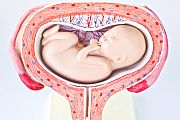For greatest decrease in neural tube defects, RBC folate concentrations should be >400 ng/mL
WEDNESDAY, April 29, 2015 (HealthDay News) — Evidence-based folate concentration guidelines for the prevention of neural tube defects (NTDs) have been developed by the World Health Organization (WHO), according to a report published in the April 24 issue of the U.S. Centers for Disease Control and Prevention’s Morbidity and Mortality Weekly Report.
Amy M. Cordero, M.P.A., from the CDC in Atlanta, and colleagues developed evidence-based guidelines on the optimal blood folate concentrations in women of reproductive age for NTD prevention. Data were included from two studies that examined the correlation between red blood cell (RBC) and folate concentrations during pregnancy and NTD risk.
According to the WHO recommendations, in order to achieve the greatest reduction of NTDs, RBC folate concentrations should be >400 ng/mL in women of reproductive age. The RBC folate threshold of >400 ng/mL can be used as an indicator of folate insufficiency, but this threshold cannot predict the individual risk of having a NTD-affected pregnancy. For women of reproductive age, no serum folate threshold is recommended for prevention of NTDs at the population level. To obtain comparable results for RBC folate concentration across countries, microbiological assay is recommended as the most reliable choice.
“This approach can identify populations at increased risk for insufficient concentrations and allow for determination of appropriate nutritional interventions based on blood folate status and nutritional patterns of the target population to reach those most in need,” the authors write.
Full Text
Copyright © 2015 HealthDay. All rights reserved.








